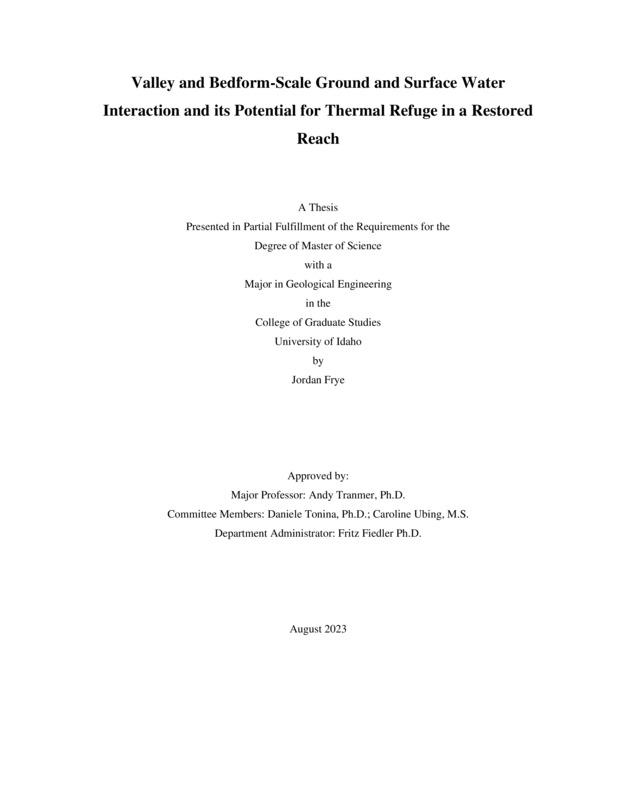Valley and bedform-scale ground and surface water interaction and its potential for thermal refuge in a restored reach
Frye, Jordan. (2023-08). Valley and bedform-scale ground and surface water interaction and its potential for thermal refuge in a restored reach. Theses and Dissertations Collection, University of Idaho Library Digital Collections. https://www.lib.uidaho.edu/digital/etd/items/frye_idaho_0089n_12660.html
- Title:
- Valley and bedform-scale ground and surface water interaction and its potential for thermal refuge in a restored reach
- Author:
- Frye, Jordan
- Date:
- 2023-08
- Keywords:
- Hyporheic Flow River Restoration Thermal Refuge
- Program:
- Civil & Environmental Engr
- Subject Category:
- Geological engineering
- Abstract:
-
Water temperature is a controlling variable that influences fish passage and migration, regulates the metabolic processes of organisms in the channel and substrate, and ultimately controls the distribution and quality of available habitat for a range of aquatic species. Anthropogenic activities and climate change have impacted stream water temperatures; therefore, the formation and restoration of thermal refuge, areas with temperature differences greater than 0.5 °C relative to average channel temperature and within the biologically required temperature range, are becoming management and restoration priorities. Currently, there is no consensus on which morphologic features (e.g., pools, riffles, alcoves, bars, and spring-fed spring channels) provide the most effective thermal refuge. Here we evaluate the effectiveness of various constructed morphologic features at creating thermal refuge over 2.5 km reach of a recently restored gravel-bed river. Wells monitored valley groundwater levels and hyporheic flux probes in the streambed quantified the direction and magnitude of hyporheic flows. In addition, a longitudinal survey was performed during summer low-flow conditions to measure water temperature and water surface elevation profiles. Results show that valley-scale groundwater-surface water gaining and losing pattern overwhelmed hyporheic exchange induced by fluvial morphologic features, e.g., pool-riffle such that their median hyporheic flux constitutes less than 0.03% of the in-stream summer low flow discharge. While hyporheic flux magnitudes were similar in pools, the accumulation of cool hyporheic flow in the low-velocity section of the pool and increased thermal buffering from solar radiation can provide thermal refuge of 0.5 °C. Secondary spring channels derived from hyporheic flows provided cool water temperatures of 13 °C, but due to low velocities and lack of shade, the water temperature rose above the stress threshold to 18 °C before it entered the river.. Constructed alcoves, riffles, and bars generated little observed thermal refuge in the study reach. Results outline the conditions of various morphologic features in generating thermal refuge that may be used to help guide future restoration projects.
- Description:
- masters, M.S., Civil & Environmental Engr -- University of Idaho - College of Graduate Studies, 2023-08
- Major Professor:
- Tranmer, Andy W
- Committee:
- Tonina, Daniele; Ubing, Caroline; Fiedler, Fritz
- Defense Date:
- 2023-08
- Identifier:
- Frye_idaho_0089N_12660
- Type:
- Text
- Format Original:
- Format:
- application/pdf
- Rights:
- In Copyright - Educational Use Permitted. For more information, please contact University of Idaho Library Special Collections and Archives Department at libspec@uidaho.edu.
- Standardized Rights:
- http://rightsstatements.org/vocab/InC-EDU/1.0/

